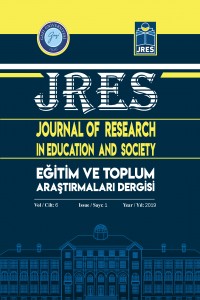Dilaver Cebeci’nin “Şimdiki Zaman Çekiminde Bir Mahkûma Mektup” Adlı Şiirinde Metinlerarasılık Unsurları
Abstract
Keywords
Metinlerarasılık Göstergelerarasılık Şimdiki Zaman Çekiminde Bir Mahkûma Mektup Dilaver Cebeci
References
- Akkale, M. (2006). Sevdiler, canlarından oldular eve dönemediler. İstanbul: Yesevî.
- Aktulum, K. (2000). Metinlerarası ilişkiler. Ankara: Öteki.
- Aktulum, K. (2004). Parçalılık metinlerarasılık. Ankara: Öteki.
- Altay, S. (2016). Bulaşıcı ve müzmin bir sosyal afet: Cumhuriyetin ilk yıllarında trahom hastalığı ve mücadele çalışmaları (1924-1938). CTAD,23, 167-211.
- Aytaç, G. (2003). Genel edebiyat bilimi, İstanbul: Say.
- Aytaş, G. (2011). Çağdaş gelişmeler ışığında şiir tahlilleri. Ankara: Akçağ.
- Banarlı, N. S. (2001). Resimli Türk edebiyatı tarihi, C: 1. İstanbul: Milli Eğitim.
- Bars, M. E. (2013). Veysel Karanî ile ilgili menkıbeler ve romanlar üzerine metinlerarası bir inceleme. Doktora Tezi, Atatürk Üniversitesi Sosyal Bilimler Enstitüsü, Erzurum.
- Bayat, F. (2017). Kadim Türklerin mitolojik hikâyeleri. İstanbul: Ötüken.
- Cebeci, D. (2009). Farklı yönleriyle Türkler. İstanbul: Bilgeoğuz.
- Cebeci, D. (2017). Mavi türkü. Ankara: Panama.
- Cebeci, D. (t.y.). Türkiyem bütün şiirleri. Ankara: Panama.
- Dilçin, C. (1995). Örneklerle Türk şiir bilgisi. Ankara: TDK.
- Diyanet İşleri Başkanlığı (2013). Hadislerle İslam, C: 7. Ankara: Diyanet İşleri Başkanlığı.
- Diyanet İşleri Başkanlığı (2014). Hadislerle İslam, C: 4. Ankara: Diyanet İşleri Başkanlığı.
- Diyanet İşleri Başkanlığı (2018). Bakara Suresi. http://kuran.diyanet.gov.tr/tefsir/Bakara-suresi/109/102-103-ayet-tefsiri sayfasından erişilmiştir.
- Diyanet İşleri Başkanlığı (t.y.). Riyâzü’s-sâlihîn metin ve çeviri, C: 1. Ankara: Diyanet İşleri Başkanlığı.
- Eskimeyen Dostlar (2007). Çankaya Marşı. Eskimeyen Dostlar: http://www.eskimeyendostlar.net/makale/cankaya-marsi/2640 sayfasından erişilmiştir.
- Gariper, K. (2017). Köroğlu ve Deli Yusuf filmlerinin göstergelerarasılık ve metinlerarasılık bağlamında değerlendirilmesi. SDÜ Fen-Edebiyat Fakültesi Sosyal Bilimler Dergisi, 42, 131-140.
- Gökalp-Alpaslan, G. G. (2006). Metinlerarası ilişkiler bağlamında cumhuriyet dönemi Türk şiirine genel bir bakış. 1. Türkiyat Araştırmaları Sempozyumu’nda sunulmuş bildiri, Ankara.
- Gökalp, Z. (2003). Türkçülüğün esasları. İstanbul: Bordo Siyah.
- Gökşen, C. & Gökşen, R. (2016). “Dağ”ın türkülere mitik bir öge olarak yansıması. A. Ü. Türkiyat Araştırmaları Dergisi (TAED),57, 1599-1618.
- Hakkı, E. İ. (t.y.). Marifetname. İstanbul: Sarmaşık.
- İhvan Blog. (2015). Kabeli Seccadede Namaz Kılınabilir mi? İhvan Blog: http://blog.ihvan.com.tr/kabeli-seccadede-namaz-kilinabilir-mi.html sayfasından erişilmiştir.
- Muhyiddin-i Arabi, (1973). Saatlerin hazinesi. İstanbul: Başaran.
- Tinhte. (2011). Duvar Kağıtları. Tinhte: https://tinhte.vn/threads/xin-wallpapers-cho-soi-hu-duoi-trang-cho-cac-may-320-240.878044/sayfasından erişilmiştir.
- Todorov, T. (2014). Poetikaya giriş. (K. Şahin, Çev.). İstanbul: Metis.
- Türk Dil Kurumu (2018). Güncel Türkçe Sözlük. http://www.tdk.gov.trsayfasından erişilmiştir.
- Türkiye Diyanet Vakfı. (1991). Türkiye Diyanet Vakfı İslam Ansiklopedisi. C: 16. Ankara: Türkiye Diyanet Vakfı.
- Türkiye Diyanet Vakfı. (2013). Türkiye Diyanet Vakfı İslam Ansiklopedisi. C: 43. Ankara: Türkiye Diyanet Vakfı.
- Türkmen, F. (1998). Tahir ile Zühre. Ankara: Atatürk Kültür Merkezi Başkanlığı.
- Ülker, T. (2017). Dilaver Cebeci. Ankara: Bilgeoğuz.
- Yıldırım, A. & Şimşek, H. (2016). Sosyal bilimlerde nitel araştırma yöntemleri. Ankara: Seçkin.
The Intertextual Elements of Dilaver Cebeci's Poem "A Letter to a Prisoner in the Present Continuous Tense"
Abstract
Keywords
Intertextuality Semiotics A Letter to a Prisoner in the Present Continuous Tense Dilaver Cebeci
References
- Akkale, M. (2006). Sevdiler, canlarından oldular eve dönemediler. İstanbul: Yesevî.
- Aktulum, K. (2000). Metinlerarası ilişkiler. Ankara: Öteki.
- Aktulum, K. (2004). Parçalılık metinlerarasılık. Ankara: Öteki.
- Altay, S. (2016). Bulaşıcı ve müzmin bir sosyal afet: Cumhuriyetin ilk yıllarında trahom hastalığı ve mücadele çalışmaları (1924-1938). CTAD,23, 167-211.
- Aytaç, G. (2003). Genel edebiyat bilimi, İstanbul: Say.
- Aytaş, G. (2011). Çağdaş gelişmeler ışığında şiir tahlilleri. Ankara: Akçağ.
- Banarlı, N. S. (2001). Resimli Türk edebiyatı tarihi, C: 1. İstanbul: Milli Eğitim.
- Bars, M. E. (2013). Veysel Karanî ile ilgili menkıbeler ve romanlar üzerine metinlerarası bir inceleme. Doktora Tezi, Atatürk Üniversitesi Sosyal Bilimler Enstitüsü, Erzurum.
- Bayat, F. (2017). Kadim Türklerin mitolojik hikâyeleri. İstanbul: Ötüken.
- Cebeci, D. (2009). Farklı yönleriyle Türkler. İstanbul: Bilgeoğuz.
- Cebeci, D. (2017). Mavi türkü. Ankara: Panama.
- Cebeci, D. (t.y.). Türkiyem bütün şiirleri. Ankara: Panama.
- Dilçin, C. (1995). Örneklerle Türk şiir bilgisi. Ankara: TDK.
- Diyanet İşleri Başkanlığı (2013). Hadislerle İslam, C: 7. Ankara: Diyanet İşleri Başkanlığı.
- Diyanet İşleri Başkanlığı (2014). Hadislerle İslam, C: 4. Ankara: Diyanet İşleri Başkanlığı.
- Diyanet İşleri Başkanlığı (2018). Bakara Suresi. http://kuran.diyanet.gov.tr/tefsir/Bakara-suresi/109/102-103-ayet-tefsiri sayfasından erişilmiştir.
- Diyanet İşleri Başkanlığı (t.y.). Riyâzü’s-sâlihîn metin ve çeviri, C: 1. Ankara: Diyanet İşleri Başkanlığı.
- Eskimeyen Dostlar (2007). Çankaya Marşı. Eskimeyen Dostlar: http://www.eskimeyendostlar.net/makale/cankaya-marsi/2640 sayfasından erişilmiştir.
- Gariper, K. (2017). Köroğlu ve Deli Yusuf filmlerinin göstergelerarasılık ve metinlerarasılık bağlamında değerlendirilmesi. SDÜ Fen-Edebiyat Fakültesi Sosyal Bilimler Dergisi, 42, 131-140.
- Gökalp-Alpaslan, G. G. (2006). Metinlerarası ilişkiler bağlamında cumhuriyet dönemi Türk şiirine genel bir bakış. 1. Türkiyat Araştırmaları Sempozyumu’nda sunulmuş bildiri, Ankara.
- Gökalp, Z. (2003). Türkçülüğün esasları. İstanbul: Bordo Siyah.
- Gökşen, C. & Gökşen, R. (2016). “Dağ”ın türkülere mitik bir öge olarak yansıması. A. Ü. Türkiyat Araştırmaları Dergisi (TAED),57, 1599-1618.
- Hakkı, E. İ. (t.y.). Marifetname. İstanbul: Sarmaşık.
- İhvan Blog. (2015). Kabeli Seccadede Namaz Kılınabilir mi? İhvan Blog: http://blog.ihvan.com.tr/kabeli-seccadede-namaz-kilinabilir-mi.html sayfasından erişilmiştir.
- Muhyiddin-i Arabi, (1973). Saatlerin hazinesi. İstanbul: Başaran.
- Tinhte. (2011). Duvar Kağıtları. Tinhte: https://tinhte.vn/threads/xin-wallpapers-cho-soi-hu-duoi-trang-cho-cac-may-320-240.878044/sayfasından erişilmiştir.
- Todorov, T. (2014). Poetikaya giriş. (K. Şahin, Çev.). İstanbul: Metis.
- Türk Dil Kurumu (2018). Güncel Türkçe Sözlük. http://www.tdk.gov.trsayfasından erişilmiştir.
- Türkiye Diyanet Vakfı. (1991). Türkiye Diyanet Vakfı İslam Ansiklopedisi. C: 16. Ankara: Türkiye Diyanet Vakfı.
- Türkiye Diyanet Vakfı. (2013). Türkiye Diyanet Vakfı İslam Ansiklopedisi. C: 43. Ankara: Türkiye Diyanet Vakfı.
- Türkmen, F. (1998). Tahir ile Zühre. Ankara: Atatürk Kültür Merkezi Başkanlığı.
- Ülker, T. (2017). Dilaver Cebeci. Ankara: Bilgeoğuz.
- Yıldırım, A. & Şimşek, H. (2016). Sosyal bilimlerde nitel araştırma yöntemleri. Ankara: Seçkin.
Details
| Primary Language | Turkish |
|---|---|
| Journal Section | Articles |
| Authors | |
| Publication Date | June 28, 2019 |
| Submission Date | May 20, 2019 |
| Published in Issue | Year 2019 Volume: 6 Issue: 1 |

This work is licensed under Creative Commons Attribution-NonCommercial-NoDerivatives 4.0 International


